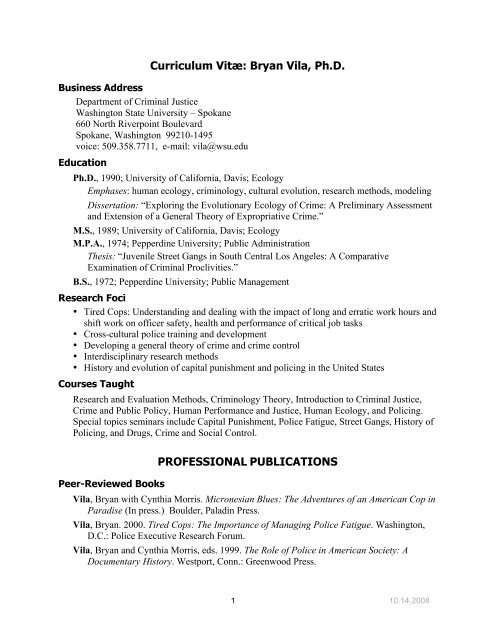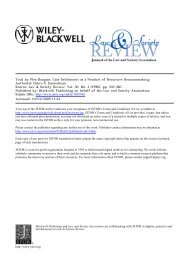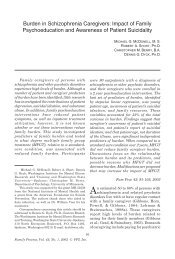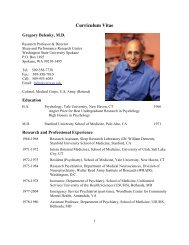Bryan Vila, Ph.D. - Washington State University at Spokane
Bryan Vila, Ph.D. - Washington State University at Spokane
Bryan Vila, Ph.D. - Washington State University at Spokane
You also want an ePaper? Increase the reach of your titles
YUMPU automatically turns print PDFs into web optimized ePapers that Google loves.
Curriculum Vitæ: <strong>Bryan</strong> <strong>Vila</strong>, <strong>Ph</strong>.D.Business AddressDepartment of Criminal Justice<strong>Washington</strong> <strong>St<strong>at</strong>e</strong> <strong>University</strong> – <strong>Spokane</strong>660 North Riverpoint Boulevard<strong>Spokane</strong>, <strong>Washington</strong> 99210-1495voice: 509.358.7711, e-mail: vila@wsu.eduEduc<strong>at</strong>ion<strong>Ph</strong>.D., 1990; <strong>University</strong> of California, Davis; EcologyEmphases: human ecology, criminology, cultural evolution, research methods, modelingDissert<strong>at</strong>ion: “Exploring the Evolutionary Ecology of Crime: A Preliminary Assessmentand Extension of a General Theory of Expropri<strong>at</strong>ive Crime.”M.S., 1989; <strong>University</strong> of California, Davis; EcologyM.P.A., 1974; Pepperdine <strong>University</strong>; Public Administr<strong>at</strong>ionThesis: “Juvenile Street Gangs in South Central Los Angeles: A Compar<strong>at</strong>iveExamin<strong>at</strong>ion of Criminal Proclivities.”B.S., 1972; Pepperdine <strong>University</strong>; Public ManagementResearch Foci• Tired Cops: Understanding and dealing with the impact of long and err<strong>at</strong>ic work hours andshift work on officer safety, health and performance of critical job tasks• Cross-cultural police training and development• Developing a general theory of crime and crime control• Interdisciplinary research methods• History and evolution of capital punishment and policing in the United <strong>St<strong>at</strong>e</strong>sCourses TaughtResearch and Evalu<strong>at</strong>ion Methods, Criminology Theory, Introduction to Criminal Justice,Crime and Public Policy, Human Performance and Justice, Human Ecology, and Policing.Special topics seminars include Capital Punishment, Police F<strong>at</strong>igue, Street Gangs, History ofPolicing, and Drugs, Crime and Social Control.Peer-Reviewed BooksPROFESSIONAL PUBLICATIONS<strong>Vila</strong>, <strong>Bryan</strong> with Cynthia Morris. Micronesian Blues: The Adventures of an American Cop inParadise (In press.) Boulder, Paladin Press.<strong>Vila</strong>, <strong>Bryan</strong>. 2000. Tired Cops: The Importance of Managing Police F<strong>at</strong>igue. <strong>Washington</strong>,D.C.: Police Executive Research Forum.<strong>Vila</strong>, <strong>Bryan</strong> and Cynthia Morris, eds. 1999. The Role of Police in American Society: ADocumentary History. Westport, Conn.: Greenwood Press.1 10.14.2008
<strong>Vila</strong>, page 2<strong>Vila</strong>, <strong>Bryan</strong> and Cynthia Morris, eds. 1997. Capital Punishment in the United <strong>St<strong>at</strong>e</strong>s: ADocumentary History. Westport, Conn.: Greenwood Press.Peer-Reviewed Articles and Book Chapters (*denotes student coauthor)<strong>Vila</strong>, <strong>Bryan</strong> and Joanne Savage. (In press.) “There’s No Such Thing as ‘A Terrorist’: UsingEvolutionary Ecology to Understand Terrorism.” In Brian Forst, Jack R. Greene and JamesP. Lynch, Security and Justice in the Homeland: Criminologists on Terrorism, Cambridge<strong>University</strong> Press, chapter 4.<strong>Vila</strong>, <strong>Bryan</strong> and Jason Moore*. (In press.) “Police Discretion, Accountability and OfficerF<strong>at</strong>igue.” In Candace McCoy (ed.), To Protect Life: Readings on Police Accountability.<strong>Ph</strong>iladelphia: Temple <strong>University</strong> Press, chapter 9.Slaven, James E., Michael E. Andrew, Anna Mn<strong>at</strong>sakanova, John M. Violanti, <strong>Bryan</strong> J. <strong>Vila</strong>,and Cecil M. Burchfiel. (In press.) “St<strong>at</strong>istical Modeling of Sleep.” Chance.<strong>Vila</strong>, <strong>Bryan</strong> and Jason Moore*. (2008) “Police Long Work Hours: Causes, Consequencesand Altern<strong>at</strong>ives.” Chapter 8 in Ronald Burke and Cary Cooper (eds.), The Long HoursWork Culture: Causes, Consequences and Choices. Bingly, UK: Emerald Publishing, pp.183-201.Violanti, John, Luenda Charles, Tara Hartley, Anna Mn<strong>at</strong>sakanova, Michael Andrew, DestaFekedulegn, <strong>Bryan</strong> <strong>Vila</strong> and Cecil Burchfiel. (2008) “Shift Work and Suicide Ide<strong>at</strong>ionamong Police Officers.” American Journal of Industrial Medicine 51:758-768.Slaven, James E., Michael E. Andrew, John M. Violanti, Cecil M. Burchfiel, AnnaMn<strong>at</strong>sakanova and <strong>Bryan</strong> <strong>Vila</strong>. (2008) “Dimensional Analysis of Actigraph-Derived SleepD<strong>at</strong>a.” Nonlinear Dynamics, Psychology and the Life Sciences 12(2), 153-161.Slaven, James E., Anna Mn<strong>at</strong>sakanova, S. Li, John M. Violanti, Cecil Burchfiel, <strong>Bryan</strong> <strong>Vila</strong>,and Michael E. Andrew. (2008) “Waiting Time Distributions of Actigraphy MeasuredSleep.” Open Sleep Journal 2:1-5.Charles, Luenda, Cecil Burchfiel, John Violanti, <strong>Bryan</strong> <strong>Vila</strong>, Tara A. Hartley and JamesSlaven. 2007. “Shift Work and Sleep: The Buffalo Police Health Study.” Policing: AnIntern<strong>at</strong>ional Journal of Police Str<strong>at</strong>egies & Management 30:215-227.Charles, Luenda, John Violanti, Cecil Burchfiel and <strong>Bryan</strong> <strong>Vila</strong>. 2007. “Obesity and Sleep:The Buffalo Police Health Study.” Policing: An Intern<strong>at</strong>ional Journal of Police Str<strong>at</strong>egies& Management 30: 203-214.<strong>Vila</strong>, <strong>Bryan</strong>. 2006. “Impact of Long Work Hours on Police Officers and the Communities TheyServe.” American Journal of Industrial Medicine 49:11, 972-980.Caruso, Claire C., Tim Bushnell, Donald Eggerth, Anneke Heitmann, Bill Kojola, K<strong>at</strong>harineNewman, Roger R. Rosa, Steven L. Sauter, and <strong>Bryan</strong> <strong>Vila</strong>. 2006. “Long Work Hours,Health, and Safety: Toward a N<strong>at</strong>ional Occup<strong>at</strong>ional Research Agenda.” American Journalof Industrial Medicine 49:11, 930-942.Slaven, John, Michael Andrew, John Violanti, Cecil Burchfiel and <strong>Bryan</strong> <strong>Vila</strong>. 2006. “ASt<strong>at</strong>istical Test to Determine Quality of Accelerometer D<strong>at</strong>a.” <strong>Ph</strong>ysiological Measurement27:413–423.10.14.2008
<strong>Vila</strong>, page 3Savage, Joanne and <strong>Bryan</strong> <strong>Vila</strong>. 2003. “Human Ecology, Crime and Crime Control: LinkingIndividual Behavior and Aggreg<strong>at</strong>e Crime.” Social Biology, 50:1-2:77-101.Reprinted as:Savage, Joanne and <strong>Bryan</strong> <strong>Vila</strong>. 2008. “Human N<strong>at</strong>ure and Crime Control: Improving theFeasibility of Nurturant Crime Control Str<strong>at</strong>egies.” In Robert D. Crutchfield, Georges S.Bridges, Joseph G. Weis and Charis Kubrin, eds. Crime: Readings, 3rd Ed. Newbury Park,Calif.: Sage.<strong>Vila</strong> <strong>Bryan</strong>, Gregory B. Morrison* and Dennis Jay Kenney. 2002. “Improving Shift Scheduleand Work-Hour Policies and Practices to Increase Police Officer Health, Safety andPerformance.” Police Quarterly, 5:1:4-24.Meeker, James, <strong>Bryan</strong> <strong>Vila</strong> and K<strong>at</strong>ie J.B. Parsons*. 2002. “GITS: A Comprehensive RegionalApproach to Street Gang Crime.” In Winfred Reed, ed. Responding to Gangs: Evalu<strong>at</strong>ionand Research. <strong>Washington</strong>, D.C.: N<strong>at</strong>ional Institute of Justice.Savage*, Joanne and <strong>Bryan</strong> <strong>Vila</strong>. 2001. “Changes in Child Welfare and Subsequent CrimeR<strong>at</strong>e Trends: Evalu<strong>at</strong>ing the Lagged Nurturance Hypothesis.” Journal of AppliedDevelopmental Psychology, 22:1-32.Meeker, James W. and <strong>Bryan</strong> <strong>Vila</strong>. 2001. “Issues in Developing and Maintaining a RegionalGang Incident Tracking System.” In C. Ronald Huff, ed. Gangs in America, 3rd Ed.Newbury Park, Calif.: Sage.<strong>Vila</strong>, <strong>Bryan</strong> and Erik Y. Taiji*. 1999. “Police Work Hours, F<strong>at</strong>igue and Officer Performance.”In Dennis Jay Kenney and Robert McNamara, eds. Police and Policing, 2nd Ed. Westport,Conn.: Praeger.Morrison*, Gregory B. and <strong>Bryan</strong> J. <strong>Vila</strong>. 1998. “Police Handgun Qualific<strong>at</strong>ion: PracticalMeasure or Aimless Activity?” Policing: An Intern<strong>at</strong>ional Journal of Police Str<strong>at</strong>egies &Management, 21:3:510-533.<strong>Vila</strong>, <strong>Bryan</strong>. 1997a. “Human N<strong>at</strong>ure and Crime Control: Improving the Feasibility of NurturantCrime Control Str<strong>at</strong>egies.” Politics and the Life Sciences 16:1:3-21.Reprinted as:<strong>Vila</strong>, <strong>Bryan</strong>. 1998. “Human N<strong>at</strong>ure and Crime Control: Improving the Feasibility of NurturantCrime Control Str<strong>at</strong>egies.” In Jodi Lane and Joan Petersilia, eds. Criminal Justice Policy.London: Edward Elgar Publishing.<strong>Vila</strong>, <strong>Bryan</strong>. 1997b. “Motiv<strong>at</strong>ing and Marketing Nurturant Crime Control Str<strong>at</strong>egies.” Politicsand the Life Sciences 16:1:48-55.Savage*, Joanne and <strong>Bryan</strong> <strong>Vila</strong>. 1997. “Lagged Effects of Nurturance on Crime: A Cross-N<strong>at</strong>ional Comparison.” Studies on Crime and Crime Prevention 6:1:101-120.<strong>Vila</strong>, <strong>Bryan</strong> and James W. Meeker. 1997. “A Regional Gang Incident Tracking System.”Journal of Gang Research 4:3:23-36.Cohen, Lawrence E. and <strong>Bryan</strong> J. <strong>Vila</strong>. 1996. “Self-Control and Social-Control: An Expositionof the Gottfredson-Hirschi/Sampson-Laub Deb<strong>at</strong>e.” Studies on Crime and CrimePrevention 5:2:125-150.<strong>Vila</strong>, <strong>Bryan</strong>. 1996. “Tired Cops: Probable Connections Between F<strong>at</strong>igue and the Performance,Health, and Safety of P<strong>at</strong>rol Officers.” American Journal of Police 15:2:51-92.10.14.2008
<strong>Vila</strong>, page 4Cohen, Lawrence E., <strong>Bryan</strong> J. <strong>Vila</strong> and Richard Machalek. 1995. “Expropri<strong>at</strong>ive Crime andCrime Policy: An Evolutionary Ecological Analysis.” Studies on Crime and CrimePrevention 4:2:197-219.<strong>Vila</strong>, <strong>Bryan</strong>. 1994. “A General Paradigm for Understanding Criminal Behavior: ExtendingEvolutionary Ecological Theory.” Criminology 32:3:311-359.Reprinted as:<strong>Vila</strong>, <strong>Bryan</strong>. 1998. “A General Paradigm for Understanding Criminal Behavior: ExtendingEvolutionary Ecological Theory.” In Gregg Barak, ed. Integr<strong>at</strong>ive Criminology. London:Ashg<strong>at</strong>e Publishing.<strong>Vila</strong>, <strong>Bryan</strong>. 1998. “A General Paradigm for Understanding Criminal Behavior.” In Stuart Henryand Werner Einstadter, eds. The Criminology Theory Reader. New York: NYU Press.<strong>Vila</strong>, <strong>Bryan</strong>. 1996. “A General Paradigm of Criminality.” In Larry Siegel and Peter Cordella, eds.Contemporary Criminological Theory. Boston: Northeastern <strong>University</strong> Press.<strong>Vila</strong>, <strong>Bryan</strong> J. and Gregory B. Morrison*. 1994. “Biological Limits to Police Comb<strong>at</strong> HandgunShooting Accuracy.” American Journal of Police 13:1:1-30.<strong>Vila</strong>, <strong>Bryan</strong> J. and Lawrence E. Cohen. 1993. “Crime as Str<strong>at</strong>egy: Testing an EvolutionaryEcological Theory of Expropri<strong>at</strong>ive Crime.” American Journal of Sociology 98:873-912.<strong>Vila</strong>, <strong>Bryan</strong> J. 1993 “Is the War on Drugs an Example of a Runaway Cultural Process?” InPeter Kraska (ed.) Altered <strong>St<strong>at</strong>e</strong>s of Mind: Critical Observ<strong>at</strong>ions of the Drug War. NewYork: Garland Press.<strong>Vila</strong>, <strong>Bryan</strong> J. 1982. “Cross Cultural Law Enforcement Development and Training: Innov<strong>at</strong>ionon the Island of Kosrae.” Police Studies 4:33-44.Peer-Reviewed Government Reports and Conference Proceedings<strong>Vila</strong>, <strong>Bryan</strong>. 2008. Utility and Suitability of RapidResponder® for Enhancing the U.S.Marshals Service’s Judicial Protection Capabilities. N<strong>at</strong>ional Institute of Justice, Office ofScience and Technology, Jan. 7.Slaven, John, Michael Andrew, John Violanti, Cecil Burchfiel and <strong>Bryan</strong> <strong>Vila</strong>. 2006.“Valid<strong>at</strong>ion of the K-st<strong>at</strong>istic for accelerometer d<strong>at</strong>a quality.” JSM Proceedings, Aug. 6-10.Meeker, James W. and <strong>Bryan</strong> <strong>Vila</strong>. 2003. Civil Ab<strong>at</strong>ement, Curfew Analysis, and DefiningGang Incidents: Further Analyses Using GITS, Orange County, California'sMulti-Jurisdictional Gang Incident Tracking System. <strong>Washington</strong>, D.C.: U.S. Departmentof Justice.Wiebe, Douglas, James W. Meeker and <strong>Bryan</strong> <strong>Vila</strong>. 2002. Hourly Trends of Gang CrimeIncidents, 1995-1998. <strong>Washington</strong>, D.C.: U.S. Department of Justice, Office of JuvenileJustice and Delinquency Prevention.<strong>Vila</strong>, <strong>Bryan</strong>. 2001. Evalu<strong>at</strong>ing the Feasibility and Utility of Forms-Scanning Software forStreamlining Crime Mapping D<strong>at</strong>a Collection and Analysis. <strong>Washington</strong>, D.C.: U.S.Department of Justice.<strong>Vila</strong>, <strong>Bryan</strong> J., Dennis Jay Kenney, Gregory B. Morrison and Melissa Reuland. 2000.Evalu<strong>at</strong>ing the Effects of F<strong>at</strong>igue on Police P<strong>at</strong>rol Officers. <strong>Washington</strong>, D.C.: U.S.Department of Justice.10.14.2008
<strong>Vila</strong>, page 5<strong>Vila</strong>, <strong>Bryan</strong> J. and James W. Meeker. 1999. Gang Activity in Orange County, California.<strong>Washington</strong>, D.C.: U.S. Department of Justice.Meeker, James W., <strong>Bryan</strong> J. <strong>Vila</strong>, Thomas E. Foss<strong>at</strong>i, Jodi S. Lane, K<strong>at</strong>ie J.B. Parsons andDouglas Wiebe. 1998. Final Report of the Orange County Consortium COPS Project:Gang Incident Tracking System. <strong>Washington</strong>, D.C.: U.S. Department of Justice, Office ofCommunity Oriented Policing Services.<strong>Vila</strong>, <strong>Bryan</strong>. 1997. “Nurturance and the Paradox of Crime Control.” Proceedings of theConference on Ethological and Developmental Approaches to Male Violence. Detroit,Mich.: Program on Medi<strong>at</strong>ing Theory and Democr<strong>at</strong>ic Systems.Scholarly Work in ProgressResearch Projects in ProgressDeveloping a F<strong>at</strong>igue Management Tool for First RespondersA N<strong>at</strong>ional Assessment of the Effects of F<strong>at</strong>igue on Police Officer Performance, Health, Safetyand Family Quality of LifeBuffalo Cardio-metabolic Occup<strong>at</strong>ional Police Stress Study (BCOPS)Applying an Integr<strong>at</strong>ed Theory of Criminal Behavior and Crime Control to Formul<strong>at</strong>e Policyand Guide PracticeBooks in Progress<strong>Vila</strong>, <strong>Bryan</strong>. No More Tired Cops: Str<strong>at</strong>egies for Managing Police F<strong>at</strong>igue<strong>Vila</strong>, <strong>Bryan</strong> and Joanne Savage. The Evolutionary Ecology of Criminal Behavior and CrimePolicyArticles and Book Chapters in Progress<strong>Vila</strong>, <strong>Bryan</strong>. (submitted) “Developing Police in Micronesia: Lessons Learned, Wh<strong>at</strong> TheyMean Today.”Violanti, John M., Cecil M. Burchfiel, , Tara A. Hartley, Anna Mn<strong>at</strong>sakanova, DestaFekedulegn, Michael Andrew, Slaven, Luenda Charles and <strong>Bryan</strong> <strong>Vila</strong>. Atypical WorkHours, Sleep, and Metabolic Syndrome among Police Officers. (submitted)<strong>Vila</strong>, <strong>Bryan</strong> and Charles Samuels. Sleep Loss in Police, First Responders, and the Military. InMeir H. Kryger, Thomas Roth, and William C. Dement (Eds.) Principles and Practice ofSleep Medicine (PPSM 5e), chapter 72.Van Dongen, Hans P.A., <strong>Bryan</strong> <strong>Vila</strong> and Gregory Belenky. “Performance Impairment fromSleep Loss and the Real World.”Slaven, James E., Michael E. Andrew, John M. Violanti, Cecil M. Burchfiel and <strong>Bryan</strong> J. <strong>Vila</strong>.“Factor Analysis and Structural Equ<strong>at</strong>ion Modeling of Actigraphy Derived SleepVariables.”Violanti, John, <strong>Bryan</strong> <strong>Vila</strong>, Cecil Burchfiel and Luenda Charles. “Gender differences indepression and shift work among police officers.”Charles, Luenda, Cecil M. Burchfiel, Dele Fekedulegn, M. Kashon, K. Krajnak, Michael E.Andrew, John M. Violanti, Diane Miller and <strong>Bryan</strong> <strong>Vila</strong>. Associ<strong>at</strong>ion Between Sleep and10.14.2008
<strong>Vila</strong>, page 6P<strong>at</strong>terns of Cortisol Secretion Among Police Officers: The Buffalo Cardio-MetabolicOccup<strong>at</strong>ional Police Stress (BCOPS) Pilot Study.”Meeker, James W., Ronald E. Wilson and <strong>Bryan</strong> <strong>Vila</strong>. “Focusing Justice Empirically:Geographic Analysis of Gang Activities for Civil Ab<strong>at</strong>ement.”<strong>Vila</strong>, <strong>Bryan</strong>, Gregory B. Morrison, Michael E. Andrew, John M. Violanti and James Slaven.“Prevalence of F<strong>at</strong>igue Among Police P<strong>at</strong>rol Officers in the United <strong>St<strong>at</strong>e</strong>s.”Public<strong>at</strong>ions for General Audiences and Practitioners<strong>Vila</strong>, <strong>Bryan</strong>. 2009. Voices from the Field: Impact of F<strong>at</strong>igue on Police Officer Stress andSafety.” In Roberg, Roy R., Kenneth Novak and Gary Cordner, Police and Society, FourthEd. New York: Oxford <strong>University</strong> Press.<strong>Vila</strong>, <strong>Bryan</strong>. 2008. “Managing Police F<strong>at</strong>igue is a High-Wire Act.” The RCMP Gazette,August.<strong>Vila</strong>, <strong>Bryan</strong> J., Christopher E. Stone and David Weisburd. 2006. “Preparing for the Future:Criminal Justice in 2040.” NIJ Journal 255:8-11, NCJ 215456.<strong>Vila</strong>, <strong>Bryan</strong>, Akiva Liberman and K<strong>at</strong>hy Browning. 2005. “Youth Violence ReductionStr<strong>at</strong>egies: <strong>St<strong>at</strong>e</strong>ment of Sarah V. Hart, Director, N<strong>at</strong>ional Institute of Justice Before theCommittee on the Judiciary, United <strong>St<strong>at</strong>e</strong>s Sen<strong>at</strong>e.” Congressional Record, Serial No. J–109–26, June 13, pp. 65-81.<strong>Vila</strong>, <strong>Bryan</strong>. 2004. “Unfit for Duty: The Impact of F<strong>at</strong>igue on Police Officer Stress andSafety.” In Roberg, Roy R., Kenneth Novak and Gary Cordner, Police and Society, ThirdEd. Los Angeles: Roxbury.<strong>Vila</strong>, <strong>Bryan</strong>. 2003. “Police Performance and Human Factors Research.” Human SystemsInform<strong>at</strong>ion Analysis Center G<strong>at</strong>eway, 8:4:18, 26.<strong>Vila</strong>, <strong>Bryan</strong>. 2002. “Cops: Learn Your A, B, Zzzzs.” The Law Enforcement Trainer, 17:44-47.<strong>Vila</strong>, <strong>Bryan</strong> and Dennis Jay Kenney. 2002. “Tired Cops: The Prevalence and PotentialConsequences of Police F<strong>at</strong>igue.” NIJ Journal 248:16-21.<strong>Vila</strong>, <strong>Bryan</strong>, Dennis Jay Kenney and Gregory B. Morrison. 2001. “The Importance ofManaging Police F<strong>at</strong>igue.” Police Chief April:188-193.<strong>Vila</strong>, <strong>Bryan</strong> and Cynthia Morris. 2000. “The Roots of Community Policing.” In QuintThurman, Jihong Zhao and Andrew Giacomazzi, Community Policing in a CommunitySetting. Los Angeles: Roxbury.<strong>Vila</strong>, <strong>Bryan</strong>. 1999. “Police F<strong>at</strong>igue: Developing Shift Schedule and Work-Hour Policies.”Proceedings of the Law Enforcement Research Networking Project and the OhioAssoci<strong>at</strong>ion of Chiefs of Police.<strong>Vila</strong>, <strong>Bryan</strong> and James W. Meeker. 1999. “Regional Vari<strong>at</strong>ion in Gang-Rel<strong>at</strong>ed CrimeP<strong>at</strong>terns: Analyzing Orange County’s Gang Incident Tracking System.” Gang-Rel<strong>at</strong>edResearch Cluster Conference Proceedings. <strong>Washington</strong>, D.C.: N<strong>at</strong>ional Institute of Justiceand Office of Juvenile Justice and Delinquency Prevention.<strong>Vila</strong>, <strong>Bryan</strong>. 1998. “We Can’t Keep Ignoring Police F<strong>at</strong>igue.” Subject to Deb<strong>at</strong>e 11:3:1-3.<strong>Vila</strong>, <strong>Bryan</strong>. 1997. “Modific<strong>at</strong>ions Not Needed in the General Paradigm for UnderstandingCriminal Behavior.” Politics and the Life Sciences 16:2:315.10.14.2008
<strong>Vila</strong>, page 7Richerson, Peter J, Monique Borgerhoff Mulder and <strong>Bryan</strong> J. <strong>Vila</strong>. 1995. Principles of HumanEcology. Needham Heights, Mass.: Simon and Schuster Custom Publishing.<strong>Vila</strong>, <strong>Bryan</strong> J. 1995. “Does the ‘War on Drugs’ Protect Our Young People?” In ArnoldTrebach and Whitney Taylor, eds. Bringing the Harm Reduction Community Together: APolicy Track Manual. <strong>Washington</strong>, D.C.: Drug Policy Found<strong>at</strong>ion.<strong>Vila</strong>, <strong>Bryan</strong> J. 1992. “The Cops’ Code of Silence.” Christian Science Monitor Aug. 31, p. 18.<strong>Vila</strong>, <strong>Bryan</strong> J. 1984. “Policy Implic<strong>at</strong>ions of Japanese Organized Crime Activities in the TrustTerritory of the Pacific Islands.” Congressional Record, June 12.<strong>Vila</strong>, <strong>Bryan</strong> J. 1981. “Management Control of F<strong>at</strong>igue Among Field Police Officers.” PoliceStress 3:3:38-41.Webb, Carolyn A. and <strong>Bryan</strong> J. <strong>Vila</strong>. 1979. “Improving Justice in Micronesia.” MicronesianReporter 27:3:20-25.RELEVANT EMPLOYMENT2005-present Professor of Criminal Justice and Director, Critical Job Task Simul<strong>at</strong>ionLabor<strong>at</strong>ory, Sleep and Performance Research Center, <strong>Washington</strong> <strong>St<strong>at</strong>e</strong> <strong>University</strong>.2002-2005 Chief, Crime Control and Prevention Research Division (GS-15), N<strong>at</strong>ional Instituteof Justice, U.S. Department of Justice. Direct an interdisciplinary staff of social andbehavioral scientists, analysts and support staff managing more than 100 research andevalu<strong>at</strong>ion grants worth roughly $35 million. Recommend research policy for the Instituteregarding criminal justice issues associ<strong>at</strong>ed with crime prevention and control, developstr<strong>at</strong>egies for achieving those policies, and supervise professional staff throughout the grantmaking process. Oversee development of budget requests, research initi<strong>at</strong>ives, conferences,personnel development plans, and administr<strong>at</strong>ive policies. Represent the Institute <strong>at</strong>professional conferences, meetings, and on boards. Develop rel<strong>at</strong>ionships with a wide arrayof domestic and foreign government and priv<strong>at</strong>e organiz<strong>at</strong>ions in order to build cooper<strong>at</strong>iveresearch initi<strong>at</strong>ives and leverage funding. Maintain an active personal research agenda.1997-2002 Associ<strong>at</strong>e Professor, Department of Criminal Justice, <strong>University</strong> of Wyoming.Founding director, Wyoming St<strong>at</strong>istical Analysis Center for Rural Policy Studies (2000-2001). Senior Research Fellow, The Policy Lab.1990-1997 Associ<strong>at</strong>e Professor [1997]/Assistant Professor, Department of Criminology, Law& Society, School of Social Ecology, UC Irvine. Founding director, Focused ResearchGroup on Orange County Street Gangs, March 1995-June 1997.1986-90 Ecology <strong>Ph</strong>D program <strong>at</strong> <strong>University</strong> of California, Davis. U.C. President’sDissert<strong>at</strong>ion Fellow, student commencement speaker.1984-86 Emergency Preparedness Coordin<strong>at</strong>or (GM-14), U.S. Department of the Interior andChief, Division of Enforcement and Security Management. Coordin<strong>at</strong>ed n<strong>at</strong>ionwidedepartmental planning and policy formul<strong>at</strong>ion for n<strong>at</strong>ural and man-made disasters,continuity of government and wartime industrial mobiliz<strong>at</strong>ion. Provided law enforcementand public safety policy guidance for U.S. overseas territories.10.14.2008
<strong>Vila</strong>, page 81980-84 Director, Trust Territory Bureau of Investig<strong>at</strong>ion, Trust Territory of the PacificIslands (TTPI). As a member of the High Commissioner’s Cabinet, directed lawenforcement, security and public safety programs and oper<strong>at</strong>ions in the emerging n<strong>at</strong>ions ofMicronesia. Developed, implemented and conducted successful cross-cultural trainingprograms tailored to each island’s needs. Conducted investig<strong>at</strong>ions and tactical oper<strong>at</strong>ionswhich were beyond the jurisdiction or capability of local law enforcement organiz<strong>at</strong>ions.Particip<strong>at</strong>ed in intern<strong>at</strong>ional symposia; testified before U.S. and foreign legisl<strong>at</strong>ive bodies.1978-80 Police Specialist, Justice Improvement Commission, TTPI. Managed Federal grantsrel<strong>at</strong>ed to public safety development in the emerging island n<strong>at</strong>ions of Micronesia, a threemillionsquare mile area with eight major languages and cultures. Assessed lawenforcement and public safety needs, designed training and development programs,acquired funding, implemented and conducted the programs, then monitored and evalu<strong>at</strong>edtheir progress.1969-78 Police Officer and Sergeant, Los Angeles County Sheriff’s Department. Assignmentsincluded Executive Planning Council staff, supervision of high-security jail popul<strong>at</strong>ions,supervision of p<strong>at</strong>rol personnel and gang units in East Los Angeles, development andconduct of training programs <strong>at</strong> the Sheriff’s Academy and p<strong>at</strong>rol in South-Central LosAngeles.1968-69 Marine Biology Aide, Naval Undersea Research and Development Center, PointMugu, Calif. Cared for and trained marine mammals. Assisted with the collection of d<strong>at</strong>aand conduct of experiments rel<strong>at</strong>ed to the animals’ physiological and sensory capabilities.1964-67 Field communic<strong>at</strong>ions specialist, U.S. Marine Corps. Duty assignments in the United<strong>St<strong>at</strong>e</strong>s, Japan and Vietnam.COMPETITIVE GRANTS AND FELLOWSHIPSExtramural Grants (1993-2004): $2,185,501“Developing a Common Metric for Evalu<strong>at</strong>ing Police Performance in Deadly ForceSitu<strong>at</strong>ions.” N<strong>at</strong>ional Institute of Justice: $282,551 (2008).“Critical Job Tasks Simul<strong>at</strong>ion Labor<strong>at</strong>ory Expansion for WSU Sleep & Performance ResearchCenter.” Office of Naval Research: $610,960 (2008).“School Safety Police Technology Evalu<strong>at</strong>ion Research Contract.” N<strong>at</strong>ional Institute of Justice:$180,135 (2008).“The Cop Crunch: Identifying Str<strong>at</strong>egies for Dealing Effectively with the Recruiting andHiring Crisis in Law Enforcement” (through Police Executive Research Forum). N<strong>at</strong>ionalInstitute of Justice: $210,996 (2001).“Evalu<strong>at</strong>ing the Feasibility and Utility of Forms-Scanning Software for Streamlining CrimeMapping D<strong>at</strong>a Collection & Analysis” (through the <strong>University</strong> of Wyoming). N<strong>at</strong>ionalInstitute of Justice: U.S. $84,614 (1999).“Further Analysis Using Orange County’s Multi-Jurisdictional Gang Incident TrackingSystem” (through UC Irvine). N<strong>at</strong>ional Institute of Justice: $103,060 (1998).10.14.2008
<strong>Vila</strong>, page 9“Evalu<strong>at</strong>ing the Effects of F<strong>at</strong>igue on Police P<strong>at</strong>rol Officers and Their Rel<strong>at</strong>ions with theCommunity” (through Police Executive Research Forum). N<strong>at</strong>ional Institute of Justice:$285,123 (1997).“Gang Activity in Orange County” (through UC Irvine). N<strong>at</strong>ional Institute of Justice: $226,384(1996).“Evalu<strong>at</strong>ion of Orange County Gang Intervention Efforts” (through UC Irvine). U.S.Department of Justice, Community Oriented Policing Services office: $176,678 (1996).“Orange County Gang Incident Tracking System” (through UC Irvine). Pacific MutualFound<strong>at</strong>ion: $25,000 (1995).Intramural Grants (1989-2002): $35,000<strong>University</strong> of Wyoming Faculty Basic Research Grant: $2,000 (2000)UC Irvine Faculty Development Fellowship: one quarter course release (1996)UC Irvine Faculty Research Fellowship: $1,500 (1995)UC Irvine Faculty Research Fellowship: $1,200 (1993)Testing an Evolutionary Ecological Theory of Crime. UC Irvine Faculty Research Fellowship:$10,000 (1991)<strong>University</strong> of California President’s Dissert<strong>at</strong>ion Year Fellowship: $20,000 (1989)Awards, Accomplishments and HonorsSPECIAL DISTINCTIONSGuest Researcher, Centers for Disease Control, N<strong>at</strong>ional Institute for Occup<strong>at</strong>ional Safety andHealth, Health Effects Labor<strong>at</strong>ory (2007- )Particip<strong>at</strong>ed in a N<strong>at</strong>ional Sleep Found<strong>at</strong>ion taskforce advising the Nuclear Regul<strong>at</strong>oryCommission on f<strong>at</strong>igue/fitness for duty rules for (10 CFR Part 26, RIN 3150–AF12) th<strong>at</strong>were adopted for the nuclear power industry (2005-07).Pioneered a novel n<strong>at</strong>ional research agenda focused on police performance issues, gainedpolitical and financial support, developed research design criteria, educ<strong>at</strong>ed researchers andpractitioners, obtained $3 million in funding, leveraged th<strong>at</strong> funding into $11 million inresearch grants by developing cooper<strong>at</strong>ive agreements with other federal research agencies(1996-2004).Developed the concept of a criminal justice st<strong>at</strong>istical analysis center for st<strong>at</strong>e of Wyoming,obtained political and financial support, helped implement the center and served as itsfounding director. The center now unifies collection and analysis of st<strong>at</strong>ewide crime,educ<strong>at</strong>ion, health, and family services d<strong>at</strong>a–Wyoming is the only st<strong>at</strong>e to do so (1997-01).Helped develop the Focused Research Group on Orange County Street Gangs <strong>at</strong> UC Irvine andserved as founding director (1995-97). During my direct involvement with the FRG, itproduced more than 12 refereed public<strong>at</strong>ions, guided local gang prevention and suppressionefforts for six years, supported five doctoral dissert<strong>at</strong>ions, and brought in $531,122 inexternal grant funding.10.14.2008
<strong>Vila</strong>, page 10Distinguished Interdisciplinary Research Award, Social Ecology Associ<strong>at</strong>es, UC Irvine (1992).Student speaker for Gradu<strong>at</strong>e Division Commencement Ceremony <strong>at</strong> UC Davis (1990).Successfully lobbied members of the U.S. Congress over a three-year period for the inclusionof long-term law enforcement technical assistance and training for the emerging n<strong>at</strong>ions ofMicronesia in enabling legisl<strong>at</strong>ion for the Compacts of Free Associ<strong>at</strong>ion (enacted 1986).Nomin<strong>at</strong>ed for Federal Law Enforcement Officer of the Year Award by U.S. Department of theInterior (1982).Particip<strong>at</strong>ed in N<strong>at</strong>ional Security Council Working Group formul<strong>at</strong>ing policy for U.S. responseto civil unrest on Kwajalein Atoll, played key role in defusing physical confront<strong>at</strong>ions andavoiding bloodshed (1982).Elected Rapporteur of Anti-Fraud and Anti-Smuggling Conference for Asia and the Pacificsponsored by United N<strong>at</strong>ions Economic and Social Commission for Asia and the Pacific,K<strong>at</strong>hmandu, Nepal (1982).Elected Vice-Chair of Anti-Fraud and Anti-Smuggling Conference for Asia and the Pacificsponsored by United N<strong>at</strong>ions Economic and Social Commission for Asia and the Pacific,Bangkok, Thailand (1981).Appointed chairman, Trust Territory of the Pacific Islands Personnel Appeals Board (1979-80).Commend<strong>at</strong>ions for Outstanding ServiceExcellence in Advising Award from students <strong>at</strong> <strong>University</strong> of Wyoming (2002).UC Irvine Senior Class Award “Most Outstanding Professor [among 43 faculty] in the Schoolof Social Ecology” (1993).Order of Omega certific<strong>at</strong>e of appreci<strong>at</strong>ion for “outstanding commitment to students” by UCIrvine sororities/fr<strong>at</strong>ernities (1992-94).U.S. Department of Justice for assistance with drug enforcement efforts (1984).Trust Territory of the Pacific Islands for performance in law enforcement and public safetyleadership positions during a six-year period (1984).Feder<strong>at</strong>ed <strong>St<strong>at</strong>e</strong>s of Micronesia Congress for developing and implementing a regional policetraining academy (1983).U.S. Department of the Army for actions on Kwajalein Atoll during civil unrest (1982).Republic of Palau Obiil Era Kelulau [N<strong>at</strong>ional Congress] for assistance with development of an<strong>at</strong>ional constitution (1981).Trust Territory of the Pacific Islands for actions during jailbreak on island of Ponape (1980).Kosrae <strong>St<strong>at</strong>e</strong> Legisl<strong>at</strong>ure, Governor, and Feder<strong>at</strong>ed <strong>St<strong>at</strong>e</strong>s of Micronesia congress for service aschief of police (1979).Los Angeles County Sheriff’s Department for actions during various tactical emergencies(1972, ‘73, ’75).Military Awards and Decor<strong>at</strong>ionsPurple Heart Medal, Vietnam Campaign Medal, Vietnam Service Medal, N<strong>at</strong>ional DefenseService Medal10.14.2008
<strong>Vila</strong>, page 11N<strong>at</strong>ional ServicePROFESSIONAL SERVICE ACTIVITIESEvalu<strong>at</strong>ed the utility and suitability of RapidResponder ® , a critical incident preparedness andresponse technology, for enhancing the U.S. Marshals Service’s judicial protectioncapabilities n<strong>at</strong>ionwide. N<strong>at</strong>ional Institute of Justice, Office of Science and Technology(2007-08).Member, Advisory Committee, Buffalo Cardiometabolic Occup<strong>at</strong>ional Police Stress Study,NIOSH & <strong>University</strong> of Buffalo (2004- ).Member, Advisory Panel for Police Officer Emergency/Disaster Training: Development ofStress-Reduction Components, a Temple <strong>University</strong> project (2005- ).Member, Security Evalu<strong>at</strong>ions Planning Committee, N<strong>at</strong>ional Science Found<strong>at</strong>ion/Office ofScience and Technology Policy (2005)Member, Trans-N<strong>at</strong>ional Institutes of Health Coordin<strong>at</strong>ing Committee (2004-2005)Member, Sleep Disorders Research Advisory Board, N<strong>at</strong>ional Heart, Lung, and BloodInstitute, N<strong>at</strong>ional Institutes of Health (2004-2005)U.S. Department of Justice represent<strong>at</strong>ive, Federal Interagency Working Group in the Social,Behavioral and Economic Sciences (2003-2005)Executive planning committee member, n<strong>at</strong>ional implement<strong>at</strong>ion of the White House CriminalJustice DNA initi<strong>at</strong>ive (2003-2005)Member, U.S. Centers for Disease Control/N<strong>at</strong>ional Institute for Occup<strong>at</strong>ional Safety & Healthteam establishing a n<strong>at</strong>ional occup<strong>at</strong>ional research agenda on long work hours (2003-07)Planning committee member, 6 th Intern<strong>at</strong>ional Work Stress and Health Conference, AmericanPsychological Associ<strong>at</strong>ion/NIJ (2003-06)Planning committee member, Long Working Hours, Safety, and Health: Toward a N<strong>at</strong>ionalResearch Agenda conference, CDC/<strong>University</strong> of Maryland (2003-04)Executive planning committee member, annual Criminal Justice Research and Evalu<strong>at</strong>ionConference (2003, 2004)Planning committee member, N<strong>at</strong>ional Summit to Prevent Drowsy Driving (2001-02)Advisor to N<strong>at</strong>ional Sleep Found<strong>at</strong>ion regarding law enforcement-rel<strong>at</strong>ed issues (2002- )Testimony before U.S. House of Represent<strong>at</strong>ives Foreign Affairs Committee Chairmanregarding law enforcement problems in the U. S. Trust Territory of the Pacific Islands.<strong>Washington</strong>, D.C. (1984)Testimony before U.S. House of Represent<strong>at</strong>ives Subcommittee on Public Lands and N<strong>at</strong>ionalParks. “Policy Implic<strong>at</strong>ions of Japanese Organized Crime Activities in the Trust Territoryof the Pacific Islands.” <strong>Washington</strong>, D.C. (1984)Testimony before Republic of Palau Constitutional Convention Committee on Civil Libertiesand Fundamental Rights regarding capital punishment and incarcer<strong>at</strong>ion. Koror, Palau(1979)10.14.2008
<strong>Vila</strong>, page 12Professional Associ<strong>at</strong>ion MembershipAmerican Associ<strong>at</strong>ion for the Advancement of ScienceAmerican Society of CriminologyAcademy of Criminal Justice SciencesIntern<strong>at</strong>ional Associ<strong>at</strong>ion of Chiefs of PoliceConsultanciesAdvisor and trainer to Se<strong>at</strong>tle Police Department regarding officer f<strong>at</strong>igue policy,countermeasures and management (2008- ).Member, Oper<strong>at</strong>ional Neuroscience Research Team for Advanced Brain Monitoring, Inc.DARPA/DSO Acceler<strong>at</strong>ed Learning projects.Advisor to Port Authority of New York and New Jersey regarding management of swornofficers’ work hours and f<strong>at</strong>igue (2008-).Evalu<strong>at</strong>or and advisor to N<strong>at</strong>ional Institute of Justice, Office of Science and Technologyregarding school safety and critical incident technologies (2007- ).Advisor to Oakland (Calif.) Police Officers’ Associ<strong>at</strong>ion regarding shift work, work hours andf<strong>at</strong>igue management (2007).Advisor to Oakland, Calif. Police Department regarding shift work, work hours and f<strong>at</strong>iguemanagement (2007- )Advisor to Calgary Police Service regarding shift work, work hours and f<strong>at</strong>igue management(2006- )Advisor to Toronto Police Associ<strong>at</strong>ion regarding shift-work (2006-07)Advisor to Canadian Professional Police Associ<strong>at</strong>ion on police work-hour issues (2006-07)Advisor to American Prosecutors Research Institute on identity theft and identity-rel<strong>at</strong>ed fraud(2005)Advisor to N<strong>at</strong>ional Sleep Found<strong>at</strong>ion re N<strong>at</strong>ional Action Plan To Prevent Drowsy Driving(2003)Expert witness re police f<strong>at</strong>igue in U.S. v. Wallace Hooks and Ryan Griner (19 Aug. 2003)Advisor to Nuclear Regul<strong>at</strong>ory Commission regarding nuclear power plant security personnelhours-of-work regul<strong>at</strong>ions (2002)Expert advisor in Amadou Diallo shooting case (1999)Advisor to Wyoming Governor’s Substance Abuse and Violent Crime Advisory Board (1998-2002)Grant ReviewerCenter for Disease Control, N<strong>at</strong>ional Science Found<strong>at</strong>ion, N<strong>at</strong>ional Institute of Justice, U.S.Department of <strong>St<strong>at</strong>e</strong>, American <strong>Ph</strong>ilosophical SocietyEditorial Board MemberPolice Quarterly10.14.2008
<strong>Vila</strong>, page 13Journal RefereeAmerican Journal of Sociology, American Sociological Review, Criminology, Evolution andHuman Behavior, Human N<strong>at</strong>ure, Industrial Health, Journal of Quantit<strong>at</strong>ive Criminology,Journal of Research on Crime and Delinquency, Policing: An Intern<strong>at</strong>ional Journal of PoliceStr<strong>at</strong>egies and Management, Social Problems, Social Science Computing Review, Studies onCrime and Crime Prevention, Theoretical Criminology, Traum<strong>at</strong>ologyPre-Public<strong>at</strong>ion Book ReviewerCambridge <strong>University</strong> Press, Oxford <strong>University</strong> Press, Prentice Hall, Prometheus Books,Wadsworth-WestProfessional Associ<strong>at</strong>ion ServiceDivision Chair, American Society of Criminology 2001 conference (2000-01)Secretary, Police Section, Academy of Criminal Justice Sciences (1999-2001)Awards Committee, American Society of Criminology (1998-99)Intern<strong>at</strong>ional Criminology Committee, Academy of Criminal Justice Sciences (1998-2002)<strong>University</strong> Committees & ServiceGradu<strong>at</strong>e Educ<strong>at</strong>ion and Research Committee, College of Liberal Arts, <strong>Washington</strong> <strong>St<strong>at</strong>e</strong><strong>University</strong>—<strong>Spokane</strong> campus represent<strong>at</strong>ive (2008– )Scientific Advisory Group, <strong>Spokane</strong> Heart Study (2007- )<strong>Washington</strong> <strong>St<strong>at</strong>e</strong> <strong>University</strong>, Academic Showcase Committee (2006-07)Wyoming St<strong>at</strong>istical Analysis Center for Rural Policy Studies Advisory Committee (2001-02)<strong>University</strong> of Wyoming Law School Internal Review Committee (1999-2000)<strong>University</strong> of Wyoming Academic Sen<strong>at</strong>e (1999-2000)<strong>University</strong> of Wyoming GIS-Sp<strong>at</strong>ial D<strong>at</strong>a Committee (1998-2002)<strong>University</strong> of California, Irvine Alcohol & Chemical Dependencies Certific<strong>at</strong>ion AdvisoryCommittee (1994-96)<strong>University</strong> of California, Irvine Truman Fellowship screening and student prepar<strong>at</strong>ioncommittee (1993-97)Faculty advisor to UC Irvine Puerto Rican Students Associ<strong>at</strong>ion (1993)<strong>University</strong> of California N<strong>at</strong>ure Reserve System advisory committee (1991-94)<strong>University</strong> of California, Irvine Human Subjects Review Committee (1991-93)<strong>University</strong> of California, Irvine Regent’s Lecturers and Professors Committee (1991-95)School of Social Ecology Underrepresented Student Programs Committee (1991-93)School of Social Ecology Computer Committee (1992-94)Faculty advisor to UC Irvine Vietnamese Students Associ<strong>at</strong>ion (1991)<strong>University</strong> of California, Davis Human Subjects Review Committee (1988-90)10.14.2008
<strong>Vila</strong>, page 14Other Professional Public ServiceMember, <strong>Washington</strong> <strong>St<strong>at</strong>e</strong> Criminal Justice Training Commission, Police Officer Certific<strong>at</strong>ionBoard (2006- )Member, <strong>Washington</strong> Attorney General’s Task Force on Identity Theft (2006- )Member, N<strong>at</strong>ional Sleep Found<strong>at</strong>ion Advisory Board reviewing Nuclear Regul<strong>at</strong>oryCommission proposed work-hour regul<strong>at</strong>ions (2005- )Faculty Associ<strong>at</strong>e, WSU Institute for the Study of Intercommunal Conflict (2008- )Wyoming st<strong>at</strong>e represent<strong>at</strong>ive to Justice Research St<strong>at</strong>istics Associ<strong>at</strong>ion (2000-01)Deleg<strong>at</strong>e, Western Governor’s Associ<strong>at</strong>ion Drug Policy Conference (2000-01)Participant, N<strong>at</strong>ional Institute of Justice Crime Mapping & D<strong>at</strong>a Confidentiality Roundtable(1999)Member, Orange County, Calif. Gang Str<strong>at</strong>egy Steering Committee (1995-98)Invited Present<strong>at</strong>ionsPUBLIC SPEAKING2008 “Why Drowsy Driving is a Thre<strong>at</strong>.” Evergreen Safety Council, Drowsy DrivingConference, Portland, O.R., 30 Sept.2008 “F<strong>at</strong>igue Management: Health and Safety Impacts, and Countermeasures th<strong>at</strong> Work.”ORC Worldwide Fortune 500 Western Occup<strong>at</strong>ional Health meeting, Santa Barbara,Calif., 3 Sept.2008 “Tired Cops Might Avoid Being Held Accountable, But Their Departments Won’t.”Intern<strong>at</strong>ional Associ<strong>at</strong>ion of Law Enforcement Planners, Sioux City, I.A., 18 Sept.2008 “Str<strong>at</strong>egic Planning for Evalu<strong>at</strong>ing Active Shooter Simul<strong>at</strong>ions.” U.S. Department ofJustice, School Safety Technical Working Group, Annapolis, M.D., 28 April 28.2007 “Changing Organiz<strong>at</strong>ions to Manage Shift Work, Work Hours and Wellness.”Intern<strong>at</strong>ional Associ<strong>at</strong>ion of Law Enforcement Planners, Calgary, Alberta, 15 Oct.2007 “Plan for Good Decisions on Shift Work, Work Hours and Wellness.” Intern<strong>at</strong>ionalAssoci<strong>at</strong>ion of Law Enforcement Planners, Calgary, Alberta, 15 Oct.2007 “Saving Tired Cops/Cops Stopping Drowsy Driving.” Wake Up Michigan! Symposium,Michigan Office of Highway Safety Planning, Grand Rapids, Mich. 20 Sept.2007 “Potential New Tools for Dealing With Police F<strong>at</strong>igue & Stress.” U.S. Department ofJustice, Body Armor Technology Working Group, <strong>Spokane</strong>, W.A. 21 August.2007 “F<strong>at</strong>igue Management with Police.” ORC Worldwide Fortune 500 Occup<strong>at</strong>ional Safetyand Health Group, <strong>Washington</strong>, D.C. 8 Aug.2007 “Police Technology Evalu<strong>at</strong>ion: Are You One With the Force?” Training seminar forN<strong>at</strong>ional Institute of Justice managers, <strong>Washington</strong>, D.C. 25 May.2007 “The Most Important Piece of Protective Technology is a Brain: How Sleep, Stress andEquipment Design Affect Safety, Performance & Health.” U.S. Department of Justice, LawEnforcement Personal Protective Equipment TWG Meeting, Albuquerque, N.M. 22 May.10.14.2008
<strong>Vila</strong>, page 152007 “Impact of Work Hours on Police Officer Performance, Health and Safety.” CalgaryPolice Service Shift Scheduling Workshop, Calgary, Alberta, March 21.2006 “Running on Empty: How F<strong>at</strong>igue Hinders Disaster Response and Counter-TerrorEfforts.” <strong>Washington</strong> <strong>St<strong>at</strong>e</strong> <strong>University</strong> 3 rd Friday speaking series, October 20.2006 “Healthier, Safer Cops & Communities: Why Police F<strong>at</strong>igue is a Labour Issue.” CanadianProfessional Police Associ<strong>at</strong>ion Executives & Directors Meeting, Calgary, October 14.2006 “Healthier, Safer Cops & Communities: Using Research to Help Manage OfficerF<strong>at</strong>igue.” <strong>Washington</strong> Associ<strong>at</strong>ion of Sheriffs and Police Chiefs Spring Conference, May24.2006 “Consequences of F<strong>at</strong>igue on Disaster Response & Counter-Terror Efforts.” Plenaryspeaker, 6 th Intern<strong>at</strong>ional Work Stress and Health Conference, Miami, March 3.2006 “Healthier, Safer Cops & Communities: Experiment-Based Police Work-HourGuidelines.” <strong>Washington</strong> Associ<strong>at</strong>ion of Sheriffs and Police Chiefs Executive BoardMeeting, January 18.2005 “Managing Police F<strong>at</strong>igue: Busted Budgets & Officer Performance.” South DakotaSheriffs and Chiefs Associ<strong>at</strong>ion, Rapid City, S.D.2005 “Assessing the Impact of Work Hours on the Health and Safety of Police Officers.”Police Union Leadership Seminar, Labor and Worklife Program, Harvard Law School,Cambridge, Mass.2005 “Tired Cops: Sleep, Job Performance, Health and Safety.” Public Policy & SleepLeadership Forum, <strong>Washington</strong>, D.C.2005 “Randomized Control Trials in Police DNA Research.” DNA Expansion Workshop,<strong>Washington</strong>, D.C.2005 “Law Enforcement and Corrections Research: The Human Side.” N<strong>at</strong>ional Conference ofU.S. Law Enforcement Training and Coordin<strong>at</strong>ing Regional Advisory Committees,Houston, Texas.2004 “Beyond Tired Cops F<strong>at</strong>igue, Human Performance and Justice.” Research TriangleInstitute, Intern<strong>at</strong>ional, Durham, N.C.2004 “Beyond Tired Cops F<strong>at</strong>igue, Human Performance and Justice.” <strong>Washington</strong> <strong>St<strong>at</strong>e</strong><strong>University</strong>, <strong>Spokane</strong>, W.A.2004 “Altern<strong>at</strong>e Futures for New York’s Crime Control Efforts.” New York <strong>St<strong>at</strong>e</strong> Division ofCriminal Justice, Albany, N.Y.2004 “Criminal Behavior & Crime Control Evolutionary Ecology’s Map for Research &Policy.” Binghamton <strong>University</strong> Conference on Community-Based Research from anEvolutionary Perspective, Binghamton, N.Y.2004 “<strong>Ph</strong>ysical and Psychological Issues Arising Out Of Shift Work.” Psychological &<strong>Ph</strong>ysical Issues Workshop for Public Safety Employees, San Diego, Calif.2004 “Future Directions for <strong>St<strong>at</strong>e</strong> Crime Control Efforts.” N<strong>at</strong>ional Institute of Justice/N<strong>at</strong>ionalGovernors Associ<strong>at</strong>ion Joint Policy Conference, Savannah, Georgia.2004 “Impact of Demographic & Technological Change on Crime and Crime Control: 2004 to2044.” NIJ Annual Research & Evalu<strong>at</strong>ion Conference plenary, <strong>Washington</strong>, D.C.10.14.2008
<strong>Vila</strong>, page 162004 “Policing’s Future: Adapting to Evolving Thre<strong>at</strong>s to Public Safety” Israeli Public SafetyMinistry/U.S. N<strong>at</strong>ional Institute of Justice meeting, New York City, with Thom Feucht.2004 “Police Officer Performance, Health, Safety, and Sleep Disorders.” N<strong>at</strong>ional Institutes ofHealth, Sleep Disorders Research Advisory Board, Bethesda, M.D.2004 “Meeting the Challenge of Police Stress and F<strong>at</strong>igue.” N<strong>at</strong>ional Weed and Seed LawEnforcement Conference, Buffalo, N.Y.2004 “Tired Cops, Tired People: Causes and Solutions.” Maryland Department ofTransport<strong>at</strong>ion Highway Conference, Frederick, Maryland.2004 “Police Long Working Hours: Problems and Opportunities.” Long Working Hours,Safety, and Health: Toward a N<strong>at</strong>ional Research Agenda conference, Baltimore, Maryland.2004 “Boosting the Impact of Technology with Social Science Research.” N<strong>at</strong>ional LawEnforcement and Corrections Technology Center Advisory Council annual meeting, SanDiego, Calif.2004 “Developing a Joint Agenda for Police F<strong>at</strong>igue and Stress Research” N<strong>at</strong>ional Institutefor Occup<strong>at</strong>ional Safety and Health, Health Effects Labor<strong>at</strong>ory, Morgantown W.V.2004 “Mapping Gang Crime: The Orange County, Calif. Gang Incident Tracking System(GITS).” Urban Institute, <strong>Washington</strong>, D.C.2003 “Why are Law Enforcement Officers Tired?” Maryland Distracted & Drowsy DrivingAwareness Seminar, Hagerstown, Maryland.2003 “Managing F<strong>at</strong>igue Post 9/11: Overtime, Busted Budgets and Officer Performance.”Police Executive Research Forum annual conference, <strong>Washington</strong>, D.C.2003 “Police Work Hours and F<strong>at</strong>igue.” FBI N<strong>at</strong>ional Academy guest lecture, Quantico,Virginia.2003 “Using Geographic Inform<strong>at</strong>ion Science to Aid Criminal Justice Research and Practice.”<strong>University</strong> Consortium for Geographic Inform<strong>at</strong>ion Science Winter Meeting, <strong>Washington</strong>,D.C.2003 “Key Issues in Engaging Police in Community-Based Drowsy Driving Educ<strong>at</strong>ion.”N<strong>at</strong>ional Highway Traffic Safety Administr<strong>at</strong>ion, <strong>Washington</strong>, D.C.2002 “The Role of Law Enforcement in Preventing Drowsy Driving.” N<strong>at</strong>ional DrowsyDriving Summit, N<strong>at</strong>ional Academy of Sciences, <strong>Washington</strong>, D.C.2002 “Police Work Hours and F<strong>at</strong>igue.” N<strong>at</strong>ional Occup<strong>at</strong>ional Research Agenda WorkingGroup, N<strong>at</strong>ional Institute for Occup<strong>at</strong>ional Safety and Health, Cincinn<strong>at</strong>i, Ohio.2001 “The Case for Practical Optimism About Crime Control and Prevention.” N<strong>at</strong>ionalInstitute of Justice, <strong>Washington</strong>, D.C.2001 “Arguing the De<strong>at</strong>h Penalty, An Historical Overview.” Simpson Memorial Public Forum.Laramie, Wyoming.2001 “Techniques for Managing Police F<strong>at</strong>igue.” Cheyenne Police Department. Cheyenne,Wyoming.2000 “A Crime Control Str<strong>at</strong>egy for the 21st Century.” Current Issues and Emerging TrendsSymposium, N<strong>at</strong>ional Interagency Civil-Military Institute. San Luis Obisbo, Calif.10.14.2008
<strong>Vila</strong>, page 172000 “A Wyoming Crime Control Str<strong>at</strong>egy for the 21st Century.” Wyoming N<strong>at</strong>ional Experts’Think Tank 2020: Cre<strong>at</strong>ing a Vision for Wyoming conference. Jackson, Wyoming2000 “Finding the Political Will to Invest in the Future.” We Need to Talk: A CommunityDialogue on Substance Abuse. Cheyenne, Wyoming.1999 “A Wyoming Crime Control Str<strong>at</strong>egy for the 21st Century.” Governor’s Substance Abuseand Violent Crime Advisory Board. Cheyenne, Wyoming.1999 “Police F<strong>at</strong>igue: Developing Shift Schedule and Work-Hour Policies.” Ohio PoliceChiefs’ Associ<strong>at</strong>ion Seminar. Columbus, Ohio.1999 “Gang Incident Tracking System Analysis.” NIJ/OJJDP Gang Research ClusterConference. <strong>Washington</strong>, D.C.1999 “Police F<strong>at</strong>igue.” N<strong>at</strong>ional Law Enforcement Families Symposium. San Antonio, Texas.1999 “The Orange County Response to Gangs: A Practitioner/Researcher Partnership.”N<strong>at</strong>ional Youth Gang Symposium. Las Vegas, Nevada.1999 “Police Officer Stress, F<strong>at</strong>igue and Burnout.” Midwestern Criminal Justice Institute daylongworkshop. Wichita, Kansas.1998 “F<strong>at</strong>igue and Police Officers.” N<strong>at</strong>ional Conference on Community Policing-Wh<strong>at</strong>Works: Research and Practice. Arlington, Virginia.1998 “F<strong>at</strong>igue and Police Officers.” N<strong>at</strong>ional Community Policing Conference. Portland,Oregon.1998 “Can We Control Crime?” UWYO Day of Classes public lecture. Laramie, Wyoming.1998 “F<strong>at</strong>igue and Police Ethics.” Wyoming Associ<strong>at</strong>ion of Sheriffs and Chiefs of PoliceExecutive Issues Symposium. Douglas, Wyoming.1998 “We Can Control Crime.” League of Women Voters of Wyoming. Laramie, Wyoming.1996 “The General Evolutionary Ecological Paradigm for Understanding Criminal Behavior.”<strong>University</strong> of Cambridge, Institute of Criminology. Cambridge, England.1996 “Nurturance and the Paradox of Crime Control” Conference on Ethological andDevelopmental Approaches to Male Violence, Program on Medi<strong>at</strong>ing Theory andDemocr<strong>at</strong>ic Systems, Wayne <strong>St<strong>at</strong>e</strong> <strong>University</strong>. Detroit, Michigan.1996 “Does the War on Drugs Protect our Youths?” <strong>University</strong> of Calif., Irvine, MedicalCenter New Horizons in Pedi<strong>at</strong>rics lecture series for university and community physicians.Orange, Calif.1996 “Orange County, California’s Regional Gang Incident Tracking System.” N<strong>at</strong>ional YouthGang Symposium. Dallas, Texas.1996 “Gang Research in Orange County, California.” N<strong>at</strong>ional Institute of Justice & Office ofJuvenile Justice and Delinquency Prevention Gangs Cluster Conference. <strong>Washington</strong>, D.C.1996 “Policy Issues Associ<strong>at</strong>ed with Cross-Jurisdictional Measurement of Gang Incidents.”FBI Southwest Command College Law Enforcement Executive Development Series. SantaAna, Calif.1996 “Measuring Gang Activity in Orange County.” Social Ecology Associ<strong>at</strong>es lecture series.<strong>University</strong> of California, Irvine.10.14.2008
<strong>Vila</strong>, page 181995 “Violent Crime: Thre<strong>at</strong>s to Safety in our Streets and Schools.” UCI Symposium Series onViolence. Irvine, Calif.1995 “Breaking the Crime Control Paradox.” <strong>Washington</strong> <strong>St<strong>at</strong>e</strong> <strong>University</strong>. Pullman,<strong>Washington</strong>.1994 “Up Against a Wall: Have We Hit the Limits of Police Shooting Accuracy?” with GregMorrison. Department of Criminology, Law & Society colloquium. <strong>University</strong> ofCalifornia, Irvine.1994 “We Can Control Crime.” California <strong>St<strong>at</strong>e</strong> <strong>University</strong>, Fullerton, Guest Lecture Series.Fullerton, Calif.1992 “Is the War On Drugs Working?” UCI Lectures Series public forum speaker. Irvine,Calif.1992 “Does the ‘War on Drugs’ Protect Our Youths?” New Horizons in Pedi<strong>at</strong>rics LectureSeries. UCI Medical Center. Orange, Calif.1991 “Taking a Hard Look <strong>at</strong> Crime: Wh<strong>at</strong> Can the Federal Government Do?” U.S. Office ofPersonnel Management, Western Executive Seminar Center, workshop for seniorexecutives. Denver, Colorado.1982 “Criminal Thre<strong>at</strong>s to the Viability of Emerging Micronesian N<strong>at</strong>ions: Implic<strong>at</strong>ions forU.S. Foreign Policy and Law Enforcement.” Keynote address to Federal Law EnforcementConference on the Trust Territory of the Pacific Islands. <strong>Washington</strong>, D.C.1981 “Tailoring Law Enforcement to Meet an Island’s Needs.” Justice in Micronesia Seminar,<strong>University</strong> of Guam, Micronesian Area Resource Center. Agana, Guam.Professional Conference Present<strong>at</strong>ions2006 “Developing Police in Micronesia: Lessons Learned, Wh<strong>at</strong> They Mean Today.”American Society of Criminology Annual Conference, Los Angeles.2006 “Reversing the Vicious Cycle of Police Stress and F<strong>at</strong>igue.” 6 th Intern<strong>at</strong>ional Work Stressand Health Conference, Miami.2005 “F<strong>at</strong>igue and Police Discretionary Decision Making: Links Between Work Hours andInjustice.” American Society of Criminology Annual Conference, Toronto.2005 “Balancing Counter-Terrorism Str<strong>at</strong>egies: Lessons from Evolutionary Ecology,” withJoanne Savage. American Society of Criminology Annual Conference, Toronto.2004 “Using Hotter/Colder-Than-Expected-Spot-Methods to Map the Concentr<strong>at</strong>ion ofResearch Opportunities,” with James W. Meeker and Ronald E. Wilson. American Societyof Criminology Annual Conference, Nashville, Tenn.2004 “F<strong>at</strong>igue and Police Officer Performance, Health and Safety.” Poster present<strong>at</strong>ion,American Society of Criminology Annual Conference, Nashville, Tenn.2004 “Using GIS to Address Street Gang Crime.” 7 th Annual Intern<strong>at</strong>ional Crime MappingConference, Boston, Mass.2003 “GIS as a Tool for Analyzing Crime D<strong>at</strong>a.” Annual Conference on Criminal JusticeResearch and Evalu<strong>at</strong>ion: Enhancing Policy and Practice. <strong>Washington</strong>, D.C.10.14.2008
<strong>Vila</strong>, page 192002 “The Cop Crunch: Identifying Str<strong>at</strong>egies to Deal with the Recruiting and Hiring Crisis inLaw Enforcement,” with Lorie Fridell, Jerry Murphy and Tom Jordan. American Society ofCriminology Annual Conference.2001 “Workshop: Managing F<strong>at</strong>igue and Alertness.” 108th Annual Conference of theIntern<strong>at</strong>ional Associ<strong>at</strong>ion of Chiefs of Police. Toronto, Canada.2001 “Can Forms-Scanning Software Help Streamline Crime D<strong>at</strong>a Collection and Analysis?”Annual Conference on Criminal Justice Research and Evalu<strong>at</strong>ion: Enhancing Policy andPractice. <strong>Washington</strong>, D.C.2000 “Objective Analysis of the Effects of Retention Elections on Judges’ SentencingPractices Under the Merit Plan,” with Carter Rees and Sam Cantrell. American Society ofCriminology Annual Conference.1999 “Privacy: D<strong>at</strong>a Confidentiality vs. Freedom of Inform<strong>at</strong>ion.” Crime Mapping ResearchCenter Annual Conference. Orlando, Florida.1999 “Tired Cops: Testing Rel<strong>at</strong>ionships Between F<strong>at</strong>igue and P<strong>at</strong>rol Officer Performance,Health and Safety.” American Society of Criminology Annual Conference.1999 “Tired Cops: Results from a Study of F<strong>at</strong>igue among P<strong>at</strong>rol Officers in Four Medium-Sized Metropolitan Police Agencies.” Academy of Criminal Justice Sciences AnnualConference.1998 “Mapping Gang Incidents Across 30 Municipal Boundaries.” Mapping Out Crime: TheSecond Annual Crime Mapping Conference. Arlington, Virginia.1998 “ Evolutionary Ecology and Crime Control: Prospects for Preventing Criminality,” withJoanne Savage. American Society of Criminology Annual Conference.1998 “Policy Implic<strong>at</strong>ions of Gang Incident Tracking System (GITS) D<strong>at</strong>a,” with DouglasWiebe and James W. Meeker. American Society of Criminology Annual Conference.1998 “Fear of Crime and Gangs: Differences among White, L<strong>at</strong>ino and Vietnamese Residentsof Orange County, California,” with Jodi Lane and James W. Meeker. American Society ofCriminology Annual Conference.1998 “Gang-Rel<strong>at</strong>ed vs. Gang-Motiv<strong>at</strong>ed: An Analysis of Definitional Differences and GangIncident P<strong>at</strong>terns,” with K<strong>at</strong>ie Parsons and James Meeker. American Society ofCriminology Annual Conference.1998 “Rel<strong>at</strong>ionships Between Concentr<strong>at</strong>ions of Gang Incidents, Social and DemographicFactors and Reported Fear of Gang Crime,” with James Meeker and Douglas Wiebe.Academy of Criminal Justices Sciences Annual Conference.1998 “Fear of Gangs in Orange County, California,” with Jodi Lane and James Meeker.Western Society of Criminology Annual Conference.1998 “Changes in Child Welfare and Subsequent Crime R<strong>at</strong>e Trends: A Cross-N<strong>at</strong>ional Test ofthe Lagged Nurturance Hypothesis,” with Joanne Savage. Western Society of CriminologyAnnual Conference.1997 “Does Evolutionary Ecological Theory Tell Us Anything Unique About ControllingCrime?” with Joanne Savage. American Society of Criminology Annual Conference.10.14.2008
<strong>Vila</strong>, page 201997 “A Triangular Approach to Evalu<strong>at</strong>ing the Effectiveness of Regional Street GangPrevention, Intervention and Suppression Programs,” with James Meeker. Conference onCriminal Justice Research and Evalu<strong>at</strong>ion. <strong>Washington</strong>, D.C.1997 “Using a GIS-Based Gang Incident Tracking System to Evalu<strong>at</strong>e Intervention andViolence Reduction Programs,” with James W. Meeker. American Society of CriminologyAnnual Conference.1997 “GIS-Based Mapping of Gang Incidents in Orange County, California,” with James W.Meeker. American Society of Criminology Annual Conference.1997 “Sp<strong>at</strong>ial and Temporal Distribution of Gang Crimes,” with James Meeker and DouglasWiebe. Academy of Criminal Justices Sciences Annual Conference.1996 “Violent Crime Around the World,” with Joanne Savage. American Society ofCriminology Annual Conference.1996 “Tired Cops: Effects of F<strong>at</strong>igue on the Performance, Health and Safety of P<strong>at</strong>rolOfficers,” with Erik Taiji. American Society of Criminology Annual Conference.1996 “An Overview of the Evolution of the Capital Punishment Deb<strong>at</strong>e in the United <strong>St<strong>at</strong>e</strong>s,”with Cynthia Morris. American Society of Criminology Annual Conference.1996 “Gang Typologies and Criminal Activities,” with James Meeker. American Society ofCriminology Annual Conference.1996 “The Orange County Gang Incident Tracking System.” Academy of Criminal JusticeSciences Annual Conference.1995 “Lagged Effects of Nurturance on Crime: A Cross-N<strong>at</strong>ional Comparison,” with JoanneSavage. American Society of Criminology Annual Conference.1995 “Regional Vari<strong>at</strong>ion in Gang-Rel<strong>at</strong>ed Crime P<strong>at</strong>terns: A Preliminary Analysis of OrangeCounty’s Gang Incident Tracking System,” with James W. Meeker. American Society ofCriminology Annual Conference.1995 “Breaking the Crime Control Paradox: An Evolutionary Ecological Paradigm <strong>at</strong> Work.”American Associ<strong>at</strong>ion for the Advancement of Science poster session.1994 “Could We Break the Crime Control Paradox?” American Society of CriminologyAnnual Conference.1994 “The Evolutionary Ecology of Criminal Behavior: Breaking the Crime Control Paradox.”American Psychological Associ<strong>at</strong>ion Annual Conference.1992 “Policy Implic<strong>at</strong>ions of an Evolutionary Ecological Theory of Crime.” American Societyof Criminology Annual Conference.1991 “Is the War on Drugs an Example of a Runaway Cultural Process?” Academy ofCriminal Justice Sciences Annual Conference.1990 “Is Crime Normal?” American Society of Criminology Annual Conference.1980 “Cross Cultural Law Enforcement Development and Training.” Academy of CriminalJustice Sciences Annual Conference.1980 “Management Implic<strong>at</strong>ions of F<strong>at</strong>igue Among Field Police Officers.” WesternAssoci<strong>at</strong>ion of Criminal Justice Educ<strong>at</strong>ors Annual Conference.10.14.2008
















